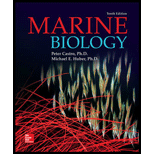
Concept explainers
To determine: The group or groups in which bilateral symmetry would expect to occur if it were to evolve among cnidarians.
Introduction: Animal phylogeny is a rapidly changing field for the biologists. Even if the members of animal kingdom are incredibly diverse, there are various animals sharing certain features that are similar to that of other organisms of the kingdom.
Explanation of Solution
If bilateral symmetry were to evolve among cnidarians, it would expect to develop among the groups of non-sessile, mobile cnidarians, such as jellyfish.
To explain: The reason why if bilateral symmetry were to evolve among cnidarians, it would expect to develop among the groups of non-sessile, mobile cnidarians.
Introduction: Animal phylogeny is a rapidly changing field for the biologists. Even if the members of animal kingdom are incredibly diverse, there are various animals sharing certain features that are similar to that of other organisms of the kingdom.
Explanation of Solution
Phylum Cnidaria comprises approximately 9000 species. It includes hydra, jellyfish, sea anemones, corals, and so on. The body is composed of only two layers of cells. The body exhibits radial symmetry. Bilateral symmetry is particularly advantageous in non-sessile animals. This is because the adaptive advantages of bilateral symmetry are to develop a head along the anteroposterior axis. Thus, it would be expected to develop among the groups of non-sessile, mobile cnidarians.
Want to see more full solutions like this?
Chapter 7 Solutions
Marine Biology (Botany, Zoology, Ecology and Evolution)
- In one paragraph show how atoms and they're structure are related to the structure of dna and proteins. Talk about what atoms are. what they're made of, why chemical bonding is important to DNA?arrow_forwardWhat are the structure and properties of atoms and chemical bonds (especially how they relate to DNA and proteins).arrow_forwardThe Sentinel Cell: Nature’s Answer to Cancer?arrow_forward
- Molecular Biology Question You are working to characterize a novel protein in mice. Analysis shows that high levels of the primary transcript that codes for this protein are found in tissue from the brain, muscle, liver, and pancreas. However, an antibody that recognizes the C-terminal portion of the protein indicates that the protein is present in brain, muscle, and liver, but not in the pancreas. What is the most likely explanation for this result?arrow_forwardMolecular Biology Explain/discuss how “slow stop” and “quick/fast stop” mutants wereused to identify different protein involved in DNA replication in E. coli.arrow_forwardMolecular Biology Question A gene that codes for a protein was removed from a eukaryotic cell and inserted into a prokaryotic cell. Although the gene was successfully transcribed and translated, it produced a different protein than it produced in the eukaryotic cell. What is the most likely explanation?arrow_forward
- Molecular Biology LIST three characteristics of origins of replicationarrow_forwardMolecular Biology Question Please help. Thank you For E coli DNA polymerase III, give the structure and function of the b-clamp sub-complex. Describe how the structure of this sub-complex is important for it’s function.arrow_forwardMolecular Biology LIST three characteristics of DNA Polymerasesarrow_forward
 Concepts of BiologyBiologyISBN:9781938168116Author:Samantha Fowler, Rebecca Roush, James WisePublisher:OpenStax College
Concepts of BiologyBiologyISBN:9781938168116Author:Samantha Fowler, Rebecca Roush, James WisePublisher:OpenStax College Biology (MindTap Course List)BiologyISBN:9781337392938Author:Eldra Solomon, Charles Martin, Diana W. Martin, Linda R. BergPublisher:Cengage Learning
Biology (MindTap Course List)BiologyISBN:9781337392938Author:Eldra Solomon, Charles Martin, Diana W. Martin, Linda R. BergPublisher:Cengage Learning
 Biology 2eBiologyISBN:9781947172517Author:Matthew Douglas, Jung Choi, Mary Ann ClarkPublisher:OpenStax
Biology 2eBiologyISBN:9781947172517Author:Matthew Douglas, Jung Choi, Mary Ann ClarkPublisher:OpenStax Biology: The Dynamic Science (MindTap Course List)BiologyISBN:9781305389892Author:Peter J. Russell, Paul E. Hertz, Beverly McMillanPublisher:Cengage Learning
Biology: The Dynamic Science (MindTap Course List)BiologyISBN:9781305389892Author:Peter J. Russell, Paul E. Hertz, Beverly McMillanPublisher:Cengage Learning Biology: The Unity and Diversity of Life (MindTap...BiologyISBN:9781305073951Author:Cecie Starr, Ralph Taggart, Christine Evers, Lisa StarrPublisher:Cengage Learning
Biology: The Unity and Diversity of Life (MindTap...BiologyISBN:9781305073951Author:Cecie Starr, Ralph Taggart, Christine Evers, Lisa StarrPublisher:Cengage Learning





